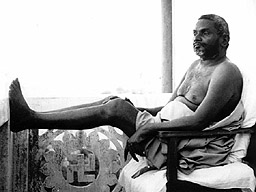The Movement Center presents Nityananda.us
Devotees' Stories
THE KANHANGAD ASHRAM
Nityananda’s work on the Kanhangad fort started around 1927. First he built a road, still used, from the traveler’s bungalow up to the rock temple and ashram. He then began clearing the jungle growth that overran the dilapidated compound. Historically the site belonged to a long line of chieftains. At one time it was in the hands of the Tulu dynasty who ruled from Mangalore to Kanhangad. Nityananda began the project to the consternation of local authorities who pestered him with questions about his activities and whether he had permission. The Master always responded that he was clearing the jungle for their future offices, a prediction that eventually came to pass.
Once the fort was cleared of overgrowth, Nityananda turned his attention to the rock itself, which is where the temple erected to him in 1963 now stands. He wanted caves hewn from the rock and, without engineers or blueprints, directed everything down to the most minute detail. The task was formidable. Using no equipment, workers carved out the caves by hand. Within three years some forty caves stood ready, properly cemented and plastered inside and out. Most were large enough for a person to sit and rest. There were six entrances; three faced east and three faced west, resulting in continuous light in the passages from sunrise to sunset.
With work proceeding on the interior of the compound, Nityananda often worked on the exterior. He made the steps and the lingas with his own hands. Following a visit to the caves in 1945, a devotee asked him about the symbolism. He replied that they represented the brain and its six passages.
Local laborers received their pay at the end of each day. Swami Janananda recalled the the foreman usually collected the money from beneath a tree. But sometimes the workers filed past Nityananda. Opening and then closing his empty fist, he would drop the exact wages into each recipient’s hand.
One day a delegation of local authorities arrived and asked him about the source of these wages. Without a word, Nityananda led them to the waterlogged field beside the rock, dived in, and emerged with a bagful of currency. He told the astonished men that a crocodile in the depths always supplied the amount he needed. He then added that they were free to find it themselves; otherwise he offered to bring up the beast for them to see.
Feeling that they had been ridiculed by this yogi in a loincloth, the angry delegates immediately reported the unauthorized construction. They told Mr. Gawne, the British tax official in South Kanara, that a crazy sannyasi was paying workers with money from unknown and mysterious sources. It seemed that Mr. Gawne had heard of Nityananda’s remarkable activities in Mangalore and decided to see for himself. Arriving at the Kanhangad railway station, he proceeded on horseback accompanied by his dog along the road built by the Master. Reaching the rock compound, he stopped and looked around. Nityananda was in a cave below the ruins on the fort’s south side. Here, the dog soon discovered him and started to bark.
He emerged from the cave and Mr. Gawne, still on horseback, asked him why he
was doing all this work and for whom. Nityananda replied in English, “Not
for this one [meaning himself]. If you want it, you may have it.” As the
words were uttered, a change came over the British official. Turning, he ordered
the local authorities to leave Nityananda alone and allow him free rein of the
site. He added that the source of funds was of no concern as long as no one
complained of being swindled or robbed. Imagine his surprise when, riding his
horse back to the station, he saw the words “Gawne Road” on the
newly erected road sign.
Next: Early Days in Ganeshpuri
